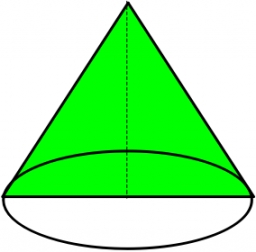Axial section of the cone
The axial section of the cone is an isosceles triangle in which the ratio of cone diameter to cone side is 2:3. Calculate its volume if you know its area is 314 cm square.
Final Answer:

Tips for related online calculators
Check out our ratio calculator.
Tip: Our volume units converter will help you convert volume units.
See also our right triangle calculator.
Calculation of an isosceles triangle.
See also our trigonometric triangle calculator.
Tip: Our volume units converter will help you convert volume units.
See also our right triangle calculator.
Calculation of an isosceles triangle.
See also our trigonometric triangle calculator.
You need to know the following knowledge to solve this word math problem:
algebrasolid geometryplanimetricsbasic operations and conceptsUnits of physical quantitiesGrade of the word problem
Related math problems and questions:
- Equilateral cone
 A cup has the shape of an equilateral cone (side “s” is the same size as the diameter of its base - the axial section is an equilateral triangle) It is supposed to hold 0.2 liters of liquid at a level 1 cm below the rim. Calculate its diameter
A cup has the shape of an equilateral cone (side “s” is the same size as the diameter of its base - the axial section is an equilateral triangle) It is supposed to hold 0.2 liters of liquid at a level 1 cm below the rim. Calculate its diameter - Axial section
 Calculate the volume and surface of a cone whose axial section is an equilateral triangle with side length a = 18cm.
Calculate the volume and surface of a cone whose axial section is an equilateral triangle with side length a = 18cm. - Equilateral cone
 The axial section of the cone is an equilateral triangle with a side of 12 cm. Surface and volume calculation.
The axial section of the cone is an equilateral triangle with a side of 12 cm. Surface and volume calculation. - Cone side
 Calculate the volume and area of the cone whose height is 10 cm, and the axial section of the cone has an angle of 30 degrees between height and the cone side.
Calculate the volume and area of the cone whose height is 10 cm, and the axial section of the cone has an angle of 30 degrees between height and the cone side. - Calculate 4842
 The area of the rotating cylinder shell is half the area of its surface. Calculate the surface of the cylinder if you know that the diagonal of the axial section is 5 cm.
The area of the rotating cylinder shell is half the area of its surface. Calculate the surface of the cylinder if you know that the diagonal of the axial section is 5 cm. - Axial section
 The axial section of the cone is an equilateral triangle with an area 208 km². Calculate the volume of the cone.
The axial section of the cone is an equilateral triangle with an area 208 km². Calculate the volume of the cone. - Angle of cone
 The cone has a base diameter of 1.5 m. The angle at the central apex of the axial section is 86°. Calculate the volume of the cone.
The cone has a base diameter of 1.5 m. The angle at the central apex of the axial section is 86°. Calculate the volume of the cone.
